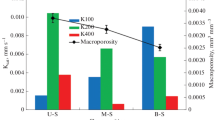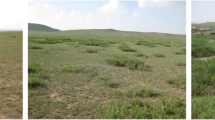Abstract
Purpose
The plateau pika (Ochotona curzoniae) is one of the main native soil faunas on the Qinghai-Tibet Plateau and plays a key role in the terrestrial ecosystem there. However, few studies have analysed the macroporosity of soils disturbed by plateau pikas in alpine meadows. The objective of this study was to examine the soil macropores in different parts of an alpine meadow in the Qinghai Lake watershed, namely, an original grassland, a new mound, an old mound, and a bald patch.
Materials and methods
In this investigation, soil cores were obtained from four different parts of an alpine meadow, namely, from under an original grassland, a new mound, an old mound, and a bald patch. A total of twelve soil cores (0–50 cm deep) were excavated, which included three replicates of each treatment. The soil architecture of each soil core was explored using X-ray computed tomography.
Results and discussion
The macroporosity decreased and then increased from the original grassland to the new mound, old mound, and bald patch. The soil macropores were most abundant up to a depth of 400 mm in the original grassland and up to a depth of 250 mm in the old mound and bald patch soils.
Conclusions
The macropores in the original grassland were attributed to well-developed root systems. The smaller and less continuous macropores in the new mound, old mound, and bald patch soils were mainly disturbed by plateau pikas. It was expected that water would move preferentially through the macropores in the original grassland, while surface flow would more readily occur in the new mound, old mound, and bald patch soils, thereby leading to soil erosion.




Similar content being viewed by others
References
Cadisch G, Willington P, Suprayogo D, Mobbs DC, van Noordwijk M, Rowe EC (2004) Catching and competing for mobile nutrients in soil. In: van Noordwijk M, Cradisch G, Ong CK (eds) Below ground interactions in tropical agroecosystems. CABI Publishing, pp 171–192
Cao JJ, Adamowski JF, Deo RC, Xu XY, Gong YF, Feng Q (2019) Grassland degradation on the Qinghai-Tibetan Plateau: reevaluation of causative factors. Rangel Ecol Manag. https://doi.org/10.1016/j.rama.2019.06.001
Capowiez Y, Pierret A, Moran CJ (2003) Characterisation of the three-dimensional structure of earthworm burrow systems using image analysis and mathematical morphology. Biol Fertil Soils 38(5):301–310
Chen J, Yi S, Qin Y (2017) A contribution of plateau pika disturbance and erosion on patchy alpine grassland soil on the Qinghai–Tibetan Plateau: implications for grassland restoration. Geoderma 297:1–9
Cheng Y, Zhang J, Pang XP, Wang Q, Zhou YP, Guo ZG (2017) Soil disturbance and disturbance intensity: response of soil nutrient concentrations of alpine meadow to plateau pika bioturbation in the Qinghai-Tibetan Plateau, China. Geoderma 307:98–106
Davidson AD, Detling JK, Brown JH (2012) Ecological roles and conservation challenges of social, burrowing, herbivorous mammals in the world’s grasslands. Front Ecol Environ 10:477–486
FEI (2016) Amira & Avizo 3D software. [WWW Document]. URL. https://www.fei.com/ software/amira-avizo/, Accessed date: 1 March 2017
Grevers MCJ, Jong ED, St Arnaud RJ (1989) The characterization of soil macroporosity with CT scanning. Can J Soil Sci 69(3):629–637
Guo ZG, Zhou XR, Hou Y (2012) Effect of available burrow densities of plateau pika (Ochotona curzoniae) on soil physicochemical property of the bare land and vegetation land in the Qinghai-Tibetan plateau. Acta Ecol Sin 32:104–110
Harris RB (2010) Rangeland degradation on the Qinghai-Tibetan Plateau: a review of the evidence of its magnitude and causes. J Arid Environ 74:1–12
Harris RB, Wenying W, Badinqiuying, Smith AT, Bedunah DJ (2015) Herbivory andCompetition of Tibetan Steppe Vegetation in WinterPasture: Effects of Livestock Exclosure and PlateauPika Reduction. PLoS ONE 10(7): e0132897
Hino M, Fujita K, Shutto H (1987) A laboratory experiment on the role of grass for infiltration and runoff processes. J Hydrol 90:303–325
Hogan BW (2010) The plateau pika: a keystone engineer on the Tibetan Plateau. Ph.D. Thesis, Arizona State University
Hu X, Liu LY, Li SJ, Cai QG, Lu YL (2012) Development of soil crusts under simulated rainfall and crust formation on a loess soil as influenced by polyacrylamide. Pedosphere 22(3):415–424
Hu X, Li ZC, Li XY, Liu Y (2015) Influence of shrub encroachment on CT-measured soil macropore characteristics in the Inner Mongolia grassland of northern China. Soil Tillage Res 150:1–9
Hu X, Li ZC, Li XY, Liu LY (2016) Quantification of soil macropores under alpine vegetation using computed tomography in the Qinghai Lake Watershed, NE Qinghai–Tibet Plateau. Geoderma 264:244-251
Hu X, Lyu YL, Liu Y, Li XY, Li ZC, Sun ZT, Cheng YQ, Guo LL, Liu LY (2018) Exclosure on CT-measured soil macropore characteristics in the Inner Mongolia grassland of northern China. J Soils Sediments 18:718–726
Jarvis NJ (2007) A review of non-equilibrium water flow and solute transport in soil macropores: principles, controlling factors and consequences for water quality. Eur J Soil Sci 58(3):523–546
Katuwal S, Norgaard T, Moldrup P, Lamandé M, Wildenschild D, Jonge LWD (2015) Linking air and water transport in intact soils to macropore characteristics inferred from X-ray computed tomography. Geoderma 237–238:9–20
Lai CH, Smith AT (2003) Keystone status of plateau pikas (Ochotona curzoniae): effect of control on biodiversity of native birds. Biodivers Conserv 12:1901–1912
Larsbo M, Koestel J, Jarvis N (2014) Relations between macropore network characteristics and the degree of preferential solute transport. Hydrol Earth Syst Sci 18:5255–5269
Li W, Zhang Y (2006) Impacts of plateau pikas on soil organic matter and moisture content in alpine meadow. Acta Theriol Sin 26:331–337
Li G, Liu Y, Frelich LE, Sun S (2011) Experimental warming induces degradation of a Tibetan alpine meadow through trophic interactions. J Appl Ecol 48:659–667
Li XY, Hu X, Zhang ZH, Peng HY, Zhang SY, Li GY, Li L, Ma YJ (2013) Shrub hydropedology: preferential water availability to deep soil layer. Vadose Zone J 12(4):1539–1663
Liu W, Xu Q, Wang X, Zhao J, Zhou L (2010) Influence of burrowing activity of plateau pikas (Ochotona curzoniae) on nitrogen in soils. Acta Theriol Sin 30:35–44
Liu YS, Fan JW, Harris W, Shao QQ, Zhou YC, Wang N, Li YZ (2013) Effects of plateau pika (Ochotona curzoniae) on net ecosystem carbon exchange of grassland in the Three Rivers Headwaters region, Qinghai-Tibet, China. Plant Soil 366:491–504
Luo LF, Lin H, Li SC (2010) Quantification of 3-D soil macropore networks in different soil types and land uses using computed tomography. J Hydrol 393(1–2):53–64
Ma YJ, Wu YN, Liu WL, Li XY, Lin HS (2018) Microclimate response of soil to plateau pika’s disturbance in the northeast Qinghai-Tibet Plateau. Eur J Soil Sci 69:232–244
Naveed M, Moldrup P, Emmanuel A, Wildenschild D, Edene M, Lamandé M, Vogel HJ, de Jonge LW (2013) Revealing soil structure and functional macroporosity along a clay gradient using x-ray computed tomography. Soil Sci Soc Am J 77:403–411
Neave M, Rayburg S (2007) A field investigation into the effects of progressive rainfall-induced soil seal and crust development on runoff and erosion rates: the impact of surface cover. Geomorphology 87:378–390
Pachepsky Y, Rawls W, Timlin D (2000) A one-parameter relationship between unsaturated hydraulic conductivity and water retention. Soil Sci 165(12):911–919
Pang XP, Guo ZG (2017) Effects of plateau pika disturbance levels on the plant diversity and biomass of an alpine meadow. Jpn Soc Grassl Sci 64:159–166
Peng CH, Ouyang H, Gao Q, Jiang Y, Zhang F, Li J, Yu Q (2007) Building a “green” railway in China. Science 316:546–547
Qin Y, Chen JJ, Yi SH (2015) Plateau pikas burrowing activity accelerates ecosystem carbon emission from alpine grassland on the Qinghai-Tibetan Plateau. Ecol Eng 84:287–291
Schlüter S, Großmann C, Diela J, Wu JM, Tischer S, Deubel A, Rücknagel J (2018) Long-term effects of conventional and reduced tillage on soil structure, soil ecological and soil hydraulic properties. Geoderma 332:10–19
Smith AT, Foggin JM (1999) The plateau pika (Ochotona curzoniae) is a keystone species for biodiversity on the Tibetan plateau. Anim Conserv 2:235–240
Smith AT, Badinqiuying WMC, Hogan BW (2019) Functional-trait ecology of the plateau pika Ochotona curzoniae (Hodgson, 1858) in the Qinghai-Xizang ecosystem. Integr Zool 14:87–103
Soto-Gómez D, Pérez-Rodríguez P, Vázquez-Juiz L, López-Periago JE, Paradelo M (2018) Linking pore network characteristics extracted from CT images to the transport of solute and colloid tracers in soils under different tillage managements. Soil Tillage Res 177:145–154
Sun FD, Chen WY, Liu L, Liu W, Cai YM, Smith P (2015) Effects of plateau pika activities on seasonal plant biomass and soil properties in the alpine meadow ecosystems of the Tibetan Plateau. Jpn Soc Grassl Sci 61:195–203
Thomson AM, Simpson IA (2007) Modeling historic rangeland management and grazing pressures in landscapes of settlement. Hum Ecol 35:151–168
Vaezi AR, Zarrinabadi E, Auerswald K (2017) Interaction of land use, slope gradient and rain sequence on runoff and soil loss from weakly aggregated semi-arid soils. Soil Tillage Res 172:22–31
Walkley A, Black IA (1934) An examination of the Degtjareff method for determining soil organic matter and a proposed modification of the chromic acid titration method. Soil Sci 37(1):29–38
Wilson MC, Smith AT (2015) The pika and the watershed: the impact of small mammal poisoning on the ecohydrology of the Qinghai–Tibetan Plateau. Ambio 44:16–22
Wu L, Wang H (2017) Poisoning the pika: must protection of grasslands be at the expense of biodiversity? Sci China Life Sci 60:245–247
Wu RX, Chai Q, Zhang JQ, Zhong MY, Liu YH, Wei XT, Pan D, Shao XQ (2015) Impacts of burrows and mounds formed by plateau rodents on plant species diversity on the Qinghai-Tibetan Plateau. Rangel J 37:117–123
Wuest SB, Williams JD, Gollany HT (2006) Tillage and perennial grass effects on ponded infiltration for seven semi-arid loess soils. J Soil Water Conserv 61:218–223
Yang ZP, Ouyang H, Xu XL, Zhao L, Song MH, Zhou CP (2010) Effects of permafrost degradation on ecosystems. Acta Ecol Sin 30(1):33–39
Yu C, Pang XP, Wang Q, Jin SH, Shu CC, Guo ZG (2017) Soil nutrient changes induced by the presence and intensity of plateau pika (Ochotona curzoniae) disturbances in the Qinghai-Tibet plateau, China. Ecol Eng 106:1–9
Zhang J, Zhang L, Liu W, Qi Y, Wo X (2014) Livestock-carrying capacity andovergrazing status of alpine grassland in the Three-River Headwaters region, China. J Geogr Sci 24(2):303–312
Zhang ZX, Chang J, Xu CY, Zhou Y, Wu YH, Chen X, Jiang SS, Duan Z (2018) The response of lake area and vegetation cover variations to climate change over the Qinghai-Tibetan Plateau during the past 30 years. Sci Total Environ 635:443–451
Zhou M, Zhu B, Wang S, Zhu X, Vereecken H, BruÈggemann N (2017) Stimulation of N2O emission by manure application to agricultural soils may largely offset carbon benefits: a global meta-analysis. Glob Chang Biol 23(10):4068–4083
Zhou Y, Li N, Grace J, Yang M, Lu C, Geng XM, Zhu XM, Zhang L, Lei GC (2018) Impact of groundwater table and plateau zokors (Myospalax baileyi) on ecosystem respiration in the Zoige Peatlands of China. PLoS ONE 9:e115542. https://doi.org/10.1371/journal.pone.0115542
Funding
This study was financially supported by the National Science Foundation of China (grant number: 41730854 & 41971053), the PCSIRT (IRT_15R06), and projects supported by the State Key Laboratory of Earth Surface Processes and Resource Ecology.
Author information
Authors and Affiliations
Corresponding author
Additional information
Responsible editor: Richard K. Shaw
Publisher’s note
Springer Nature remains neutral with regard to jurisdictional claims in published maps and institutional affiliations.
Rights and permissions
About this article
Cite this article
Hu, X., Li, XY., Li, ZC. et al. 3-D soil macropore networks derived from X-ray tomography in an alpine meadow disturbed by plateau pikas in the Qinghai Lake watershed, north-eastern Qinghai-Tibetan Plateau. J Soils Sediments 20, 2181–2191 (2020). https://doi.org/10.1007/s11368-019-02560-8
Received:
Accepted:
Published:
Issue Date:
DOI: https://doi.org/10.1007/s11368-019-02560-8




